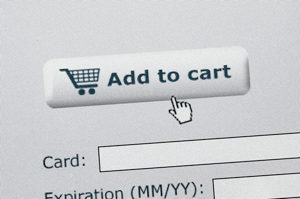According to BI Intelligence, about 74% of all online shoppers abandon their online shopping cart during the checkout process, and 12% of these abandonments are due to poor user experience.
Think about that.
For every 100 customers you get to your website’s checkout page, 74 of them leave without purchasing. Your checkout page can help or hinder when it comes to completing purchases. Here’s what you need to know to improve conversions and keep your business rolling.
DIY vs. Hosted Checkout Pages
If you aren’t technically savvy, using a hosted checkout page can be a quick way to implement secure payments with little (if any) programming work needed. Many processors offer hosted payment pages, allowing you to take cards without storing data. Hosted pages often include limited customization options, like choosing which fields to include, altering colors to match your branding, or including your business logo on the payment page. Actual customizations vary by processor.
However, if you’d like complete control over your customers’ checkout experience, you can build your own checkout flow using services like Braintree or Stripe with the help of a developer.
If you hire a developer to build your own custom checkout page, be sure to hire someone experienced in both ecommerce development and implementation of the payment processor you select.
Related Article: How to Take Credit Cards Online.
How to Improve Checkout Conversions
Maximizing conversions is crucial for a healthy business, and there are some best practices you can implement. For our business, Dozmia, we made changes to streamline the checkout page to improve the likelihood of customers completing their purchase.
Organize Products by Highest Price to Lowest Price
A house looks big until you put it next to a skyscraper.
The same works with pricing. If you have an expensive product, organizing your products from highest to lowest price can make the less expensive products seem cheaper by comparison.
For example, for our advertising packages, we have 3 options: $9/day, $17/day, and $27/day.
When we organized them from low to high, nearly 100% of customers chose the $9/day package. Flipping the prices to order from most expensive to least expensive not only increased our conversion rate, but 20% of customers opted for the $27/day package!
Use a Single Page for Checkout
People are naturally loss averse. This means that the more time someone has to think about a purchase, the more likely they are to decide against it, no matter how much it will help them.
Each additional page you add for your checkout process increases the opportunity for a customer to drop off – especially if load times between pages are too long.
Reducing the checkout process to one page can improve your conversion rate dramatically. If your checkout process is multi-step, instead of having one page for each step, segment the checkout steps onto a single page. Customers will be able to complete the process faster, and won’t have time to think about abandoning the transaction.
Ask for as Little Information as Possible During Checkout
This goes along with keeping checkout to a single page. Many checkout pages ask customers to select their card type, enter phone numbers, and more. Restrict your fields to only the information you absolutely need.
Asking customers to select their card type is an unnecessary step, as the first few digits of a credit card identify the carrier (Visa, Mastercard, etc.) and asking customers for a phone number may not be necessary, either.
Instead, just ask for what’s required from credit card processors unless you absolutely need the other information:
- Cardholder name
- Card number
- Expiration date
- Security code
- Address, if necessary
- Zip/postal code
Remember, the less info you ask for, the quicker your checkout process will be. Customers respond to fast, easy checkout procedures and abandon their orders for clunky or lengthy checkouts. If you want to boost conversions, keep the user and their experience in mind.
Related Article: Is it Worth It to Use Address Verification for Online Orders?
For Card Expiration Date Dropdowns, Include the Numbers of the Month
When looking at a credit card, the expiration date is expressed in numbers, but some checkout fields use a dropdown menu that lists the checkout month in words.
This causes customers to stop to think about the number that represents the month and slows down their entry of the proper information. Instead of listing months by their name, list them with a number and the name: For example, “01 – Jan.” This saves time and thought for your customers.
Identify Errors Before the User Clicks Your Call to Action
Many checkout pages wait until the user clicks “checkout” (or any other final call to action like “place order”) to identify errors, but making the user find the error on the page then re-enter their information can be frustrating.
Instead, have your checkout page identify errors as the user is entering their information. This way, they can fix problems immediately and are less likely to abandon due to invalid entries resulting in page refreshes that make it look like your website isn’t working.
Conclusion
There are several ways to make a checkout page that’s user-friendly and boosts your conversions. Follow these steps to streamline the payment process, and don’t be afraid to bring in a developer for any in-depth technical work. By implementing the steps above, you may be able to increase conversions on your own ecommerce site.







